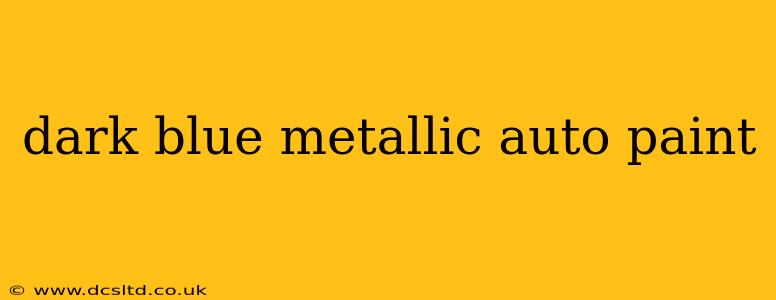Dark blue metallic auto paint offers a captivating blend of sophistication and depth, transforming any vehicle into a head-turning masterpiece. Its rich, shimmering effect is highly sought after, but achieving and maintaining this stunning finish requires careful consideration of several factors. This comprehensive guide explores everything you need to know about dark blue metallic auto paint, from choosing the right shade to ensuring its long-lasting beauty.
What are the Different Shades of Dark Blue Metallic Auto Paint?
The world of dark blue metallics is surprisingly diverse. You'll find a wide spectrum, ranging from deep, almost black hues with subtle metallic flecks to vibrant, electric blues with pronounced sparkle. Some popular shades include:
- Midnight Blue Metallic: A classic, deep blue that leans towards black in low light, revealing its metallic shimmer in brighter conditions.
- Navy Blue Metallic: A richer, more saturated blue, often with a slightly cooler undertone.
- Sapphire Blue Metallic: Evokes the brilliance of a sapphire gemstone, with intense color and dazzling metallic effects.
- Cobalt Blue Metallic: A bolder, more vibrant blue, often featuring larger metallic particles for a more pronounced shimmer.
Choosing the right shade depends entirely on personal preference and the overall aesthetic you're aiming for. Consider your vehicle's style, your personal taste, and even the lighting conditions where you'll primarily be driving it. A color that looks stunning in bright sunlight might appear much darker in low-light situations.
How is Dark Blue Metallic Auto Paint Applied?
Applying dark blue metallic auto paint requires precision and skill to achieve a flawless, even finish. The process generally involves several stages:
- Preparation: This crucial first step includes cleaning, sanding, and priming the surface to ensure proper adhesion. Any imperfections in the surface will show through the final coat.
- Base Coat: The base coat provides the foundation for the metallic color. Multiple thin coats are usually necessary for optimal coverage and color depth.
- Metallic Coat: This is where the magic happens! The metallic particles are mixed into a clear coat to create the signature shimmering effect. Careful application is key to avoid streaks or uneven distribution.
- Clear Coat: A clear coat protects the base and metallic coats, adding shine and durability. Multiple coats are typically applied, allowing each coat to dry before the next application.
- Polishing and Buffing: The final step involves polishing and buffing to remove any imperfections and achieve a mirror-like finish.
While this process can be undertaken by experienced DIY enthusiasts, professional automotive painting is often recommended, particularly for achieving a show-car-quality finish.
How Do I Maintain Dark Blue Metallic Auto Paint?
Dark blue metallic paint, with its deep color and reflective particles, can show imperfections more readily than lighter colors. Maintaining its beauty requires diligent care:
- Regular Washing: Wash your vehicle regularly with a car wash soap designed for automotive paint. Avoid harsh chemicals and abrasive materials.
- Waxing and Detailing: Regular waxing helps protect the paint from the elements and maintains its shine. Professional detailing can remove minor scratches and swirl marks.
- Avoiding Harsh Chemicals: Avoid parking under trees (sap can be difficult to remove) and be mindful of potential damage from bird droppings or other environmental contaminants. Deal with these promptly.
- Proper Storage: If storing your vehicle for an extended period, consider using a car cover to prevent dust and other environmental damage.
How much does dark blue metallic auto paint cost?
The cost of dark blue metallic auto paint varies greatly depending on the brand, quality, and quantity needed. Aerosol cans are a budget-friendly option for smaller touch-up jobs, while larger projects may require professional application with more expensive high-quality paints.
What are the pros and cons of dark blue metallic auto paint?
Pros:
- Striking and sophisticated appearance.
- Deep color and shimmering metallic effect.
- High perceived value.
Cons:
- More susceptible to showing imperfections.
- Requires more diligent maintenance.
- Can be more expensive than solid color paints.
What is the best way to repair scratches on dark blue metallic auto paint?
Minor scratches can often be buffed out with a polishing compound. For deeper scratches, touch-up paint may be necessary. However, for best results, consult a professional detailer or body shop for major damage repair to ensure a seamless match and avoid noticeable imperfections.
By understanding the nuances of dark blue metallic auto paint and following proper care and maintenance procedures, you can ensure your vehicle maintains its stunning appearance for years to come. Remember, the key is proactive care and attention to detail.
